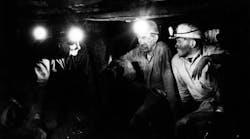MSHA’s monthly special impact inspections, which began in force in April 2010 following the explosion at the Upper Big Branch Mine, involve mines that merit increased agency attention and enforcement due to their poor compliance history or particular compliance concerns. These concerns include high numbers of violations or closure orders; frequent hazard complaints or hotline calls; plan compliance issues; inadequate workplace examinations; a high number of accidents, injuries or illnesses; fatalities; adverse conditions such as increased methane liberation, faulty roof conditions and inadequate ventilation; and respirable dust.
“We continue to identify operators who have not gotten the message,” said Joseph A. Main, assistant secretary of labor for mine safety and health. “Exposure to harmful levels of respirable dust is unacceptable. Not conducting adequate examinations is unacceptable. Miners deserve better.”
TRC Mining Corp.
For example, MSHA conducted an impact inspection at TRC Mining Corp.’s #2 mine in Letcher County, Ky., on Nov. 27. Enforcement personnel issued 23 citations and seven orders, including five unwarrantable failure orders and two failure-to-abate orders for previously issued citations. The five unwarrantable failure orders were issued for failure to follow the approved ventilation plan, failure to properly maintain and repair mine seals and failure to conduct adequate pre-shift examinations. The orders closed the entire underground portion of the mine.
Subsequent to this inspection, the mine operator changed the mine status to non-producing, with four miners working one shift per day. The operator also submitted a plan to remove equipment from the mine on Dec. 7 and to have the removal completed by Jan. 1. This was the third impact inspection at the mine.
The operator’s approved ventilation plan on the mechanized mining unit stipulates the installation of a line curtain within 14 feet of each working face with a minimum air quantity in all 10 entries. Mining was underway when inspectors arrived to find either no line curtain where required or line curtains in excess of the required 14 feet; at one point a line curtain was installed 35 feet from the face. No air movement could be detected behind the curtains in four entries, and they did not extend into the last open cross-cut to maintain the necessary minimum air quantity.
The operator also did not properly maintain the water spray system – provided for the belt drive transfer point – in an operable condition. At the time of the inspection, coal was running on the belt line at this location. The water supply had been turned off at the cutoff valve (where the branch line connects to the main water line).
The mine also was cited for violations of annual retraining requirements, inadequate roof support, no warning devices at the end of permanent roof support, blocked personnel doors along each side of the #1 beltline, pre-shift examinations not recorded, failure to maintain the primary intake escape way, accumulations of combustible material in areas of the mine, and improperly maintained mining and electrical equipment and fire suppression systems.
BHP Copper
Also last month, MSHA conducted an impact inspection at the BHP Copper Inc., Pinto Valley Operation in Gila County, Ariz., where a miner was fatally injured in a fall in September. Federal inspectors issued 40 citations and two orders during the Nov. 6-21 inspection.
Inspectors issued two unwarrantable failure orders during this inspection, one for failure to provide barricades or signs warning miners of fall hazard at the North Mine Pit, Castle Dome building. This standard has been cited five times in the past 2 years. A second such order was issued for not providing a barricade, railing or barrier to prevent miners from over-traveling a steep, uneven, rocky dropoff located south of the Rectifier Building.
Hazardous conditions resulted in six citations for damaged electrical conductors that potentially could expose miners to electrical shock . This hazardous condition has been cited 14 times in the past 2 years at this mine. Five citations were issued for failure to conduct continuity and resistance testing of the grounding system on power cords, power strips, power supplies and a portable band saw, exposing miners to possible electrical shock hazards. This standard has been cited 14 times in the past 2 years at this mine. Four citations were issued for improper storage of supplies, parts and materials and for exposing miners to slip, trip, falls and fall of material hazards. This standard has been cited eight times in the past 2 years at this mine.
Four citations were issued because high-pressure hoses located at the shop bay, electrician shop, primary crusher and secondary crusher building were not equipped with safety chains or locking devices to prevent a connection failure, creating the potential of a violent hose-whipping action if a hose came apart. This standard was cited one time in the past 2 years.
Since April 2010, MSHA has conducted 539 impact inspections and issued 9,445 citations, 900 orders and 40 safeguards.

